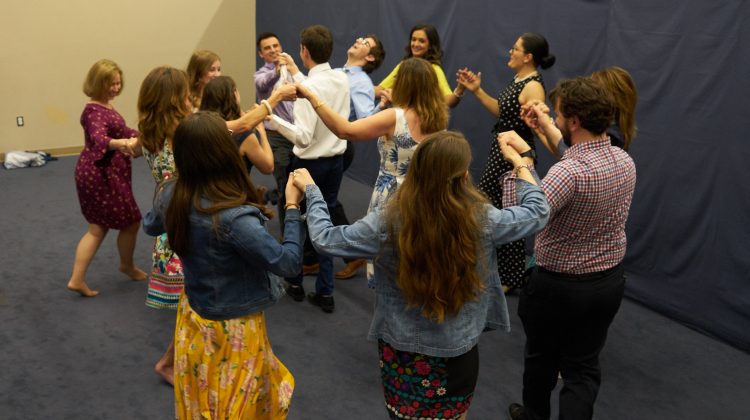This post was first published almost four years ago, and because of its relevance for the post-Pascha season, I’m revamping it for new readers and also for podcast listeners. Christ is risen! —LH
The midnight Pascha service ends, and the joyful but sleepy parishioners break out platters and crockpots for a parish feast featuring meats, cheeses, wines, homemade beers, vodka in OCA churches, and perhaps a bit of traditional dancing to bouzouki music in Greek parishes. We arrive home, exhausted, at 3 a.m. and collapse into bed.

Christ is risen! Christos anesti! Christos voskrese! al-Masih qam!
Now what?
The first answer is, we continue feasting! Bright Week began the day after Pascha, and during this fast-free time, we enjoy all kinds of meat dishes while the vegetarians among us go on a cheesy binge. (How do vegans break the fast? A question for the ages.)
In his famous 4th-century Paschal homily, St. John Chrysostom said:
If any man be devout and love God, let him enjoy this fair and radiant triumphal feast. If any man be a wise servant, let him rejoicing enter into the joy of his Lord. If any have labored long in fasting, let him now receive his recompense.

In the Resurrection of Christ, everything old is made new again. This is why we feast. The Church celebrates the ongoing reality of the Resurrection by keeping the altar doors open during Bright Week. The laity refrain from kneeling during the liturgy until Pentecost, and we sing the hymn “Christ is risen” at the beginning and end of every service. With these small but significant changes, the Church reminds us, as Fr. Aristotle W. Damaskos writes in Keeping the Light Burning, that “Christ is present and in our midst, in a special way, and awaits our response to His call.”
But our normal lives continue at home, work, and school, filled with deadlines and errands. Saint John Chrysostom taught us about how to fast in all areas of our lives. (Click here and scroll to the end of the blog post for his beautiful words on the meaning of a true fast.) But how do we feast beyond indulging in bacon cheeseburgers?
If we were paying attention at all during the Great Fast and Holy Week, we probably learned some new things about ourselves and about God. Great Lent may be over, but there are three ways we can incorporate the lessons we’ve learned into our daily lives.
1. We remind each other of the reality of the Resurrection in our greetings.

In addition to the Paschal changes during worship, we acknowledge the Resurrection in our interactions with others. From now until the Feast of the Ascension (Acts 1:9-11), forty days after Pascha, the Orthodox faithful dispense with “hello” and greet one another with the triumphal announcement, “Christ is risen!” We respond to this greeting with, “Truly (or “Indeed”) He is risen!” This simple declaration reminds us that the Resurrection of our Lord and Savior is a daily part of our lives, not a nice allegory confined to a church service. Father Ari writes, “The reality of the Resurrection is that our Lord will walk with us wherever, and whenever, we go.”
In our secular society, a hearty “Christ is risen!” might not be appreciated on the job or at school. Even our non-Orthodox Christian friends might respond with a blank stare (translation: “Um, Easter is over”) or a “Yeah, that’s right!”
Since most of us do not live, work, and study among other Orthodox people, we can silently honor the Resurrection when we greet our neighbors and coworkers by offering up a prayer for them (a good idea year-round). And we can always exchange the paschal greeting with our families in the morning and at coffee with an Orthodox Christian friend.
Enter you all into the joy of your Lord; and receive your reward, both the first, and likewise the second. You rich and poor together, hold high festival. You sober and you heedless, honor the day. Rejoice today, both you who have fasted and you who have disregarded the fast. The table is full-laden; feast ye all sumptuously. The calf is fatted; let no one go hungry away. — Paschal Homily
2. We incorporate our newly formed habits into our daily lives.

For years the experts said, “It takes three weeks to establish a habit.” I never believed it. (Have you ever tried dieting? I rest my case.) Instead, research on making and breaking habits has shown that while a simple health change might require only about 20 days of repetition to become automatic (like committing to floss our teeth every night before bed), more difficult practices may take more than 80 days, or even a year, to stick. (For more information on the subject, click here.)
It’s interesting to look at our Lenten journeys in the light of habit formation. Lent itself lasts 40 days, followed by Lazarus Saturday and Palm Sunday (sort of an “in-between” weekend), then Holy Week. That’s 49 fasting days, and if you want to include Meatfare Week right before Great Lent, which supposedly eases us into the fast by allowing dairy but no meat (Am I the only one who doesn’t find this “easy”?), we’re looking at 56 days of fasting in one form or another. Fifty-six days to form new habits.
Huh. It’s almost as if the Church knows what she’s doing.
During this season some people gave up their thrice-weekly Starbucks run, brewing their coffee at home in order to give an extra $18 per week to a food pantry. Some of us finally established a modest but achievable prayer rule—morning prayers and time spent reading the day’s Gospel and epistle passages, or maybe a chapter of spiritual reading in the evenings from The Way of the Pilgrim or the life of a saint. Others stayed away from social media.

Why would we end these practices and go back to our previous “normal”? Even when we struggled and fell, our efforts bore fruit. Our reading materials improved our attitudes, and our new prayer habits helped tame our anxious thoughts. In avoiding social media, we found a measure of contentment and fewer unnecessary sources of aggravation. By cutting expenses, we offered money to the poor and discovered that Corporate Coffee Man managed to stay in business without our six-dollar splurges.
Many of these ascetic practices can become a part of our everyday lives, now that we’ve gotten a good 56-day start in habit formation. (As always, it’s important to discuss these changes with a spiritual father who will help us discern ways to continue applying our Lenten experiences.)
O Death, where is your sting? O Hell, where is your victory? Christ is risen, and you are overthrown. Christ is risen, and the demons are fallen. Christ is risen, and the angels rejoice. Christ is risen, and life reigns.
3. We Cultivate a Mindset of Watchfulness.

Watchfulness involves being attentive to our inner selves and is translated from the Greek word nepsis, from nepho—to guard, inspect, examine, watch over, and keep under surveillance. (Personally, I prefer this term to “mindfulness,” which tends to be a popular but vague spiritual term that ignores God.) Saint Peter warns us to “be sober, be vigilant; because your adversary the devil walks about like a roaring lion, seeking whom he may devour” (I Peter 5:8). Frankly, watchfulness is often the last thing we want to practice, especially after a long period of struggle.
But the temptation after Pascha is to lose all self-control. Joyful feasting easily becomes a return to mindless snacking and indulgence. Without the pull of daily services to attend, our newfound free time offers endless opportunities to binge-watch Netflix, and our new prayer habits founder.
But by the grace of God, we can choose differently. Father Ari writes, “During this season of the Resurrection, let us continue in vigilance to build upon the good habits and virtues that were planted and begun to spring up during Lent, and allow them to be harvested by serving Christ and humanity in new ways.”
Rather than saying with relief, “Whew! I’m so glad that’s over!” let’s continue encouraging one another in vigilance, growing day by day into clearer icons of Christ, because He is risen! Truly He is risen!
Christ is risen, and not one dead remains in the grave. For Christ, being risen from the dead, is become the first fruits of those who have fallen asleep. To Him be glory and dominion unto ages of ages. Amen.
In the latter years of the fourth century Saint Gregory of Nazianzus preached in his own Paschal homily, in which he said, “Yesterday I was crucified with Christ; Today I am glorified with Him. Yesterday I died with Him; Today I am made alive with Him. Yesterday I was buried with Him; Today I am raised with Him.”
May we all know joy in this season of celebration after Pascha. Christ is risen!
Alithos Anesti! Voistynu Voskres! Haqqan Qam!

.
Thank You so much for this. You always seem to be able to put thing in perspective for me. No easy task I assure you. Christ is Risen!
Truly He is risen!
How do vegans break the fast?
Olive oil, olive oil, olive oil!
Of course! And wine. 🙂